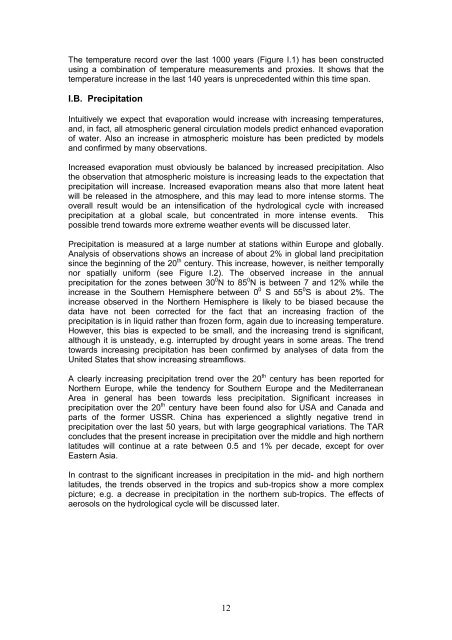Climate Change and the European Water Dimension - Agri ...
Climate Change and the European Water Dimension - Agri ...
Climate Change and the European Water Dimension - Agri ...
You also want an ePaper? Increase the reach of your titles
YUMPU automatically turns print PDFs into web optimized ePapers that Google loves.
The temperature record over <strong>the</strong> last 1000 years (Figure I.1) has been constructed<br />
using a combination of temperature measurements <strong>and</strong> proxies. It shows that <strong>the</strong><br />
temperature increase in <strong>the</strong> last 140 years is unprecedented within this time span.<br />
I.B. Precipitation<br />
Intuitively we expect that evaporation would increase with increasing temperatures,<br />
<strong>and</strong>, in fact, all atmospheric general circulation models predict enhanced evaporation<br />
of water. Also an increase in atmospheric moisture has been predicted by models<br />
<strong>and</strong> confirmed by many observations.<br />
Increased evaporation must obviously be balanced by increased precipitation. Also<br />
<strong>the</strong> observation that atmospheric moisture is increasing leads to <strong>the</strong> expectation that<br />
precipitation will increase. Increased evaporation means also that more latent heat<br />
will be released in <strong>the</strong> atmosphere, <strong>and</strong> this may lead to more intense storms. The<br />
overall result would be an intensification of <strong>the</strong> hydrological cycle with increased<br />
precipitation at a global scale, but concentrated in more intense events. This<br />
possible trend towards more extreme wea<strong>the</strong>r events will be discussed later.<br />
Precipitation is measured at a large number at stations within Europe <strong>and</strong> globally.<br />
Analysis of observations shows an increase of about 2% in global l<strong>and</strong> precipitation<br />
since <strong>the</strong> beginning of <strong>the</strong> 20 th century. This increase, however, is nei<strong>the</strong>r temporally<br />
nor spatially uniform (see Figure I.2). The observed increase in <strong>the</strong> annual<br />
precipitation for <strong>the</strong> zones between 30 0 N to 85 0 N is between 7 <strong>and</strong> 12% while <strong>the</strong><br />
increase in <strong>the</strong> Sou<strong>the</strong>rn Hemisphere between 0 0 S <strong>and</strong> 55 0 S is about 2%. The<br />
increase observed in <strong>the</strong> Nor<strong>the</strong>rn Hemisphere is likely to be biased because <strong>the</strong><br />
data have not been corrected for <strong>the</strong> fact that an increasing fraction of <strong>the</strong><br />
precipitation is in liquid ra<strong>the</strong>r than frozen form, again due to increasing temperature.<br />
However, this bias is expected to be small, <strong>and</strong> <strong>the</strong> increasing trend is significant,<br />
although it is unsteady, e.g. interrupted by drought years in some areas. The trend<br />
towards increasing precipitation has been confirmed by analyses of data from <strong>the</strong><br />
United States that show increasing streamflows.<br />
A clearly increasing precipitation trend over <strong>the</strong> 20 th century has been reported for<br />
Nor<strong>the</strong>rn Europe, while <strong>the</strong> tendency for Sou<strong>the</strong>rn Europe <strong>and</strong> <strong>the</strong> Mediterranean<br />
Area in general has been towards less precipitation. Significant increases in<br />
precipitation over <strong>the</strong> 20 th century have been found also for USA <strong>and</strong> Canada <strong>and</strong><br />
parts of <strong>the</strong> former USSR. China has experienced a slightly negative trend in<br />
precipitation over <strong>the</strong> last 50 years, but with large geographical variations. The TAR<br />
concludes that <strong>the</strong> present increase in precipitation over <strong>the</strong> middle <strong>and</strong> high nor<strong>the</strong>rn<br />
latitudes will continue at a rate between 0.5 <strong>and</strong> 1% per decade, except for over<br />
Eastern Asia.<br />
In contrast to <strong>the</strong> significant increases in precipitation in <strong>the</strong> mid- <strong>and</strong> high nor<strong>the</strong>rn<br />
latitudes, <strong>the</strong> trends observed in <strong>the</strong> tropics <strong>and</strong> sub-tropics show a more complex<br />
picture; e.g. a decrease in precipitation in <strong>the</strong> nor<strong>the</strong>rn sub-tropics. The effects of<br />
aerosols on <strong>the</strong> hydrological cycle will be discussed later.<br />
12













